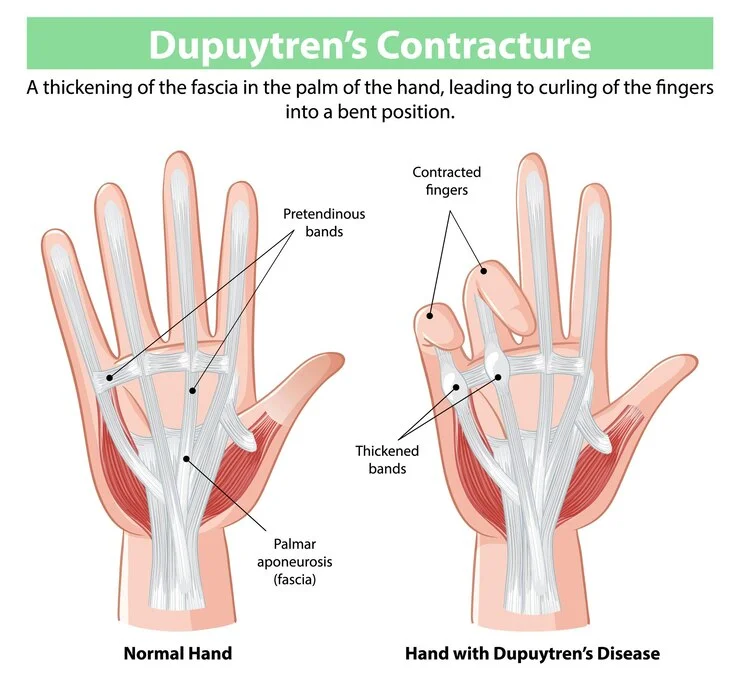Understanding Dupuytren’s Contracture: Causes, Symptoms, and Treatment Options

Dupuytren’s contracture is a hand condition where the tissue beneath the surface of the hand becomes thick and tight, causing parts of the hand to bend inwards. Named after the French surgeon Baron Guillaume Dupuytren, who first described it in 1834, this condition causes the fingers (usually the ring and little fingers) to contract inward toward the palm with limited ability to straighten.
Awareness is essential, as is timely diagnosis – after all, although Dupuytren’s contracture is seldom painful, it can have a dramatic effect on hand function. Simple movements such as shaking hands, wearing gloves, or laying your hand flat on a table can become difficult.
It is a disease of older men, especially those of northern European origin. But women and younger people can experience it too, particularly if there’s a family history. In this post, we’ll cover the phases, causes, symptoms, and treatment of Dupuytren’s contracture, helping people who are suffering from this condition (or at risk of suffering) understand this condition better.
What is Dupuytren’s Contracture?
Dupuytren’s contracture is a fibroproliferative disorder, which implies abnormal thickening and tightening of the palmar fascia (a layer of connective tissue situated under the skin of the palm). Eventually, this thickened tissue can form cords that pull one or more fingers into a permanently bent position.
The disease usually advances slowly and begins as small bumps in the palm that become tight, cordlike bands that limit the movement of the fingers. Though it does not always need immediate treatment, severe cases can result in serious disability, so early intervention is advantageous.
Stages of Dupuytren’s Contracture
1. Early Stage
- Firm lumps (nodules) of tissue develop in the palm, usually at the base of the ring or little finger.
- The nodules can be tender at first, but they usually are not painful.
- The skin might even look dimpled or puckered.
2. Intermediate Stage
- Cords of tissue become thicker and may push into the fingers.
- Fingers are starting to become hard to straighten out entirely.
- Others observe difficulty in gripping or flattening the hand.
3. Advanced Stage
- The fingers involved bend (contract) the finger towards the palm at a certain joint.
- Affected individuals have a marked functional impairment of the hand, which impacts daily living activities such as writing, typing, or grasping.
- In rare instances the disease may advance to ‘Dupuytren’s diathesis’ when it involves both the hands and other parts of the body like the knuckles or the feet.
Causes and Risk Factors
The precise aetiology of Dupuytren’s contracture is not known, though several factors increase a person’s risk of having it:
Genetic Predisposition
- It frequently clusters in families, indicating that heredity is a factor.
- More likely to affect those of Northern European descent (particularly Scandinavian, Irish, or Scottish).
Demographic Factors
- Age: It’s most common in people aged 50 and older.
- Gender: Men are up to eight times more likely to develop severe disease than women.
Associated Conditions
- Diabetes: Those with diabetes are at increased risk, though symptoms are typically milder.
- Alcoholism & Tobacco: Alcoholism, heavy tobacco and alcohol use might also play a role in its progression.
- Epilepsy & Anticonvulsant Use: Certain research has tied the extended use of anticonvulsant drugs such as phenobarbital to Dupuytren’s.
Symptoms to Watch Out For
An early recognition of the problem can help control the condition before it is exacerbated. Key symptoms include:
- Firm bumps or rigid nodules starting from in the palm, at times near the crease.
- Cords that feel like taut bands beneath the skin.
- The fingers (especially upon waking) are harder to straighten.
- Gradual stiffening that may make it harder to wash hands or put on gloves.
If you experience these symptoms, speak to a hand specialist at Chase Lodge Hospital who will assist in identifying the right treatment option.
Diagnosis of Dupuytren’s Contracture
Diagnosis is usually straightforward and involves:
- Physical examination – Assessing nodules, cords, and finger flexion.
- Tabletop test – Checking if the hand can lie flat on a surface.
- Imaging (if needed) – X-rays or ultrasounds to rule out arthritis or tendon issues.
Treatment Options
Treatment varies depending on the severity of the problem.
Observation (For Mild Cases)
- If the symptoms are not getting worse, simply observing it may be all you have to do.
Non-Surgical Treatments
- Enzyme Injections (Xiapex®): Collagenase injections soften thickened cords, and the finger can be straightened out without surgery.
- Needle Aponeurotomy (NA): A needle is inserted to release firm, tight cords, allowing improved movement without an invasive procedure.
Surgical Treatment (in severe cases)
- Fasciotomy: Excising the thickened tissue to release the finger movement.
- Dermofasciectomy: Removes diseased tissue as well as skin, with skin grafting if necessary.
Post-Treatment Rehabilitation
- Hand therapy is used to regain strength and movement.
- You may be advised to use splints or stretching moves.
Living with Dupuytren’s Contracture
Although there’s no cure, effectively managing the condition can preserve hand function:
- Keep an eye on how things are progressing with check-ups.
- Modify instruments (eg, ergonomic handles) for increased ergonomics.
- Keep them moving with workouts for your hands.
When to See a Specialist
Seek medical advice if:
- Your fingers are bending involuntarily.
- You experience difficulty with hand function.
- The condition affects your quality of life.
Early intervention can prevent severe deformity and improve outcomes.
Conclusion
Dupuytren’s contracture is a treatable condition, especially when caught early. If you suspect you may have symptoms, don’t wait—consult a specialist at Chase Lodge Hospital for a personalised assessment and treatment plan.
Contact us today to book a consultation and take the first step towards better hand health!